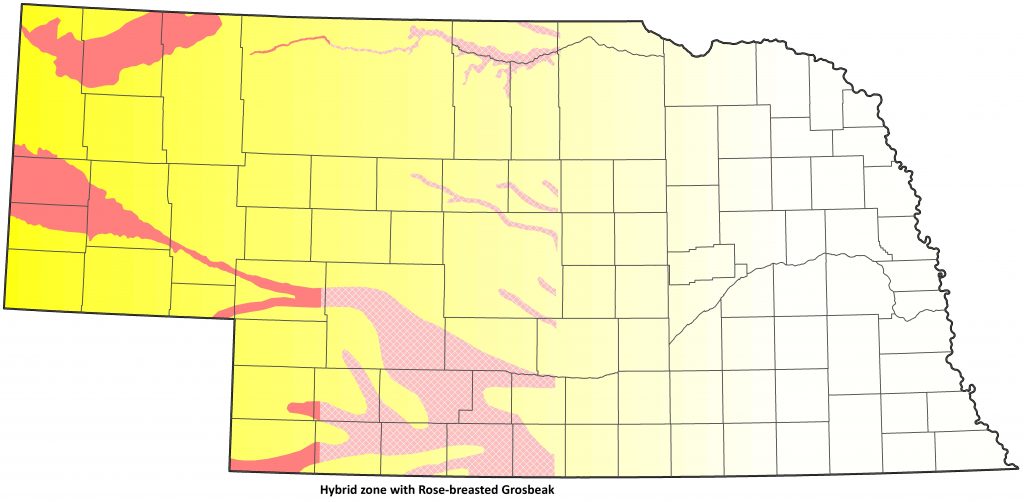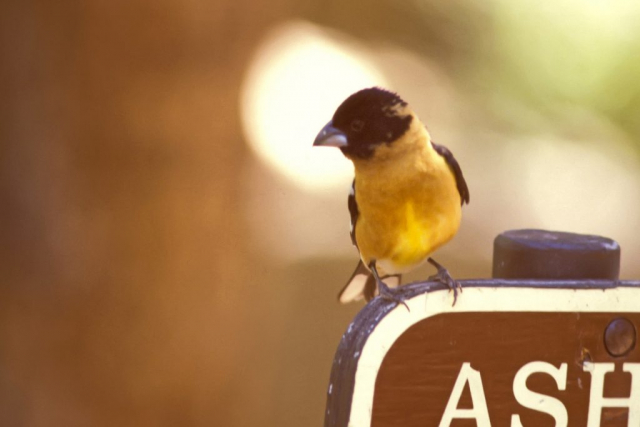Pheucticus melanocephalus melanocephalus
Status: Common regular spring and fall migrant west and central, rare southeast, rare casual northeast. Common regular breeder west and south, uncommon north, rare casual east. Rare casual winter visitor east.

Documentation: Specimen: UNSM ZM7085, 13 Jul 1901 Sioux Co.
Taxonomy: Two subspecies are recognized (AviList 2025): maculatus, breeding coastal southwest British Columbia to southern California, and melanocephalus, breeding from interior British Columbia to eastern California east to North Dakota and southwest Texas.
Nebraska birds are presumed melanocephalus.
This species hybridizes with Rose-breasted Grosbeak where the ranges of the two species meet in central Nebraska; see discussion at the Rose-breasted x Black-headed Grosbeak species account.
Intergrades with Rose-breasted Grosbeak appeared at Lancaster Co feeders 23 Aug-19 Sep 1980, 9 Aug-22 Sep 1981, and 23 Aug-27 Sep 1982. The observation of 2-3 at Towl Park, Omaha 6-8 Oct 2015 and one at Orchard Hill Greenstrip, Omaha 10 Oct 2015 were of interest in that these birds had “orangy” underparts as well as fairly extensive black streaks below, suggestive of Hatch Year birds, intergrades with Rose-breasted Grosbeak that might migrate a bit later than phenotypically pure birds, or yearling Black-headed Grosbeak males, which spend their first breeding-age summer in variable sub-adult plumages (Hill 2022).
Spring: Apr 27, 28, 30 <<<>>> summer
Arrival is typically in early May, with earliest reports in late Apr.
Migrants occur regularly east to eastern Brown Co in the Niobrara River Valley, and the Grand Island area in the Platte River Valley. Reports east of Brown Co in the north are 3 Jun 2016 Keya Paha Co, one in Rock Co 7 Jun 2023, three reports in Knox Co, 3 May 1992, 14-15 May 2007, and 16 May 1996, and singles at different locations in Madison Co 8 and 9 May 2022, and in Wayne Co 5 May 2023. In the southeast, spring records have become more numerous in recent years, bordering on annual occurrence; it was reported in 14 of the 19 years 2007-2025.
An easterly specimen, UNSM ZM10410, was taken at Lincoln, Lancaster Co 20 May 1911.
-
- High counts: 17 at Chadron Creek Ranch WMA, Dawes Co 24 May 2022, 14 at Gilbert-Baker WMA, Sioux Co 4 Jun 2020, 14 at West Ash Creek, Dawes Co 27 May 2021, and 12 at Chadron Reservoirs, Dawes Co 22 May 2023.
Summer: According to Johnsgard (1980), this species breeds commonly in the west, and eastward in the Niobrara Valley to Rock Co, in the Loup drainage to Garfield Co, and along the Platte Valley to Hall Co, the same easterly limits given by Short (1961). Swenk (1936) showed a zone of overlap with Black-headed Grosbeak approximately from Holt Co south to Webster Co. Mollhoff (2001, 2016) shows similar eastern limits, with little change since the first atlas period 1984-1989. These eastern range limits correspond approximately to the western limit of the range of Rose-breasted Grosbeak; intergrades are numerous in central Nebraska (see Rose-breasted Grosbeak and hybrid Rose-breasted Grosbeak X Black-headed Grosbeak accounts).
Black-headed Grosbeak is common in the Niobrara River Valley east to the Niobrara Valley Preserve, where Brogie and Mossman (1983) found several nests in 1982. Easterly was one at the Keya Paha River/470 Ave crossing, Boyd Co 11 Jun 2024.
It is uncommon in the Loup River drainage, where it was listed as an “uncommon summer resident and nester” in Thomas Co (Bray 1994), although “rather more common” than Rose-breasted Grosbeak. Mollhoff (2001) stated that it was “found much less often than expected along the … upper Loup Rivers”, and this status was unchanged 2006-2011 (Mollhoff 2016). One was in Greeley Co 3 Jul 2005.
The summer range in the Platte River Valley has retracted significantly during the 1940s through 1980s. Ducey (1988) indicated that it was more widespread formerly, and cited breeding records east to Lancaster and Jefferson Cos, apparently in the 1920s. An old nest record was of one with eggs in Lancaster Co collected by N. E. Goss 25 May 1889, now #95735 at the University of Kansas Biodiversity Institute (Mollhoff 2022). Swenk (1936) indicated that its range had expanded into eastern Nebraska between 1915 and 1930, and Ludlow (1935) noted that it was more common in summer than Rose-breasted Grosbeak in Webster Co. Adults feeding young were at Lincoln, Lancaster Co 19 May 1930 (Swenk 1930, Mollhoff 2022); 11 adults and three “small young” were banded at this location in 1930 (Swenk 1930). Since 1991, however, it has been reported regularly in summer only east to Buffalo and Phelps Cos. It is numerous in southeast Lincoln Co, where 12+ per day were present 15-21 Jun 2005.
It breeds regularly in the Republican River Valley eastward to the Harlan County Reservoir area, where it was reported 29 May 1994, and several were noted (along with hybrids) 23 Jun 1996. Two were in Nuckolls Co 30 Jun 2024.
There are few summer reports from the east since the 1920s: six on 10 Jun 2010 Fairmont, Fillmore Co, 21 Jun 2000 Merrick Co, 30 Jun 1964 Hamilton Co, and, from Lancaster Co, 11 Jun 1937, 28 Jun-1 Jul 1971, 10 Jul 1973, and one photographed 20 Jul 2013.
BBS trend analysis (Sauer et al 2020) shows the species has increased in Nebraska annually by 1.28% (95% C.I.; -0.81, 3.5) 1966-2019. Rose-breasted Grosbeak has showed a decline of -1.11 (95% C.I.; -2.37, -0.06) during the same period (Sauer et al 2020).
- Breeding phenology:
Nest-building: 2 Jun
Eggs: 17 May- 9 Jul (Mollhoff 2022)
Nestlings: 3-30 Jun
Fledglings: 7 Jul
Fall: summer <<<>>> Sep 20, 22, 22
Later dates are of two on 20 Oct 2004 near Valley, Douglas Co, 26 Oct 1894 Douglas Co (Swenk 1931), and 3-4 Nov 2000 at a feeder in Omaha, Douglas Co.
Latest dates are easterly and less than annual (see Winter).
Departure is in mid-Sep.
- High counts: 21 at Sowbelly Canyon, Sioux Co 13 Aug 2021.
Winter: This species has a tendency to occur in winter at feeders, often east of its normal range; breeders in the south part of the overall range, probably from Oklahoma southward, tend to be sedentary. It is “occasional” in winter in Kansas (Thompson et al 2011). There are three Nebraska reports in Jan, one of which was known to have successfully overwintered: 11 Jan-May 1970 Douglas-Sarpy Cos, Jan 1981 Cass Co (Williams 1981) and 5 Jan 1986 Lincoln Co. The 1970 bird was at an Omaha feeder and stayed until the owners departed on vacation in May (Cortelyou 1970). A Pheucticus grosbeak in an Ogallala, Keith Co yard 22 Mar 2015 feeding on suet was likely this species or an intergrade and may have wintered nearby.
Images
Abbreviations
BBS: Breeding Bird Survey
UNSM: University of Nebraska State Museum
WMA: Wildlife Management Area (state)
Literature Cited
AviList Core Team, 2025. AviList: The Global Avian Checklist, v2025. https://doi.org/10.2173/avilist.v2025.
Bray, T.E. 1994. Habitat utilization by birds in a man-made forest in the Nebraska Sandhills. M.S. thesis, University of Nebraska-Omaha.
Brogie, M.A., and M.J. Mossman. 1983. Spring and summer birds of the Niobrara Valley Preserve, Nebraska: An annotated checklist. NBR 51: 44-51.
Cortelyou, R.G. 1970. 1970 (Forty-fifth) Spring Migration and Occurrence Report. NBR 38: 74-87.
Ducey, J.E. 1988. Nebraska birds, breeding status and distribution. Simmons-Boardman Books, Omaha, Nebraska, USA.
Hill, G.E. 2022. Black-headed Grosbeak (Pheucticus melanocephalus), version 2.0. In Birds of the World (S. M. Billerman and B. K. Keeney, Editors). Cornell Lab of Ornithology, Ithaca, NY, USA. https://doi.org/10.2173/bow.bkhgro.02.
Johnsgard, P. A. 1980. A preliminary list of the birds of Nebraska and adjacent Great Plains states. Published by the author, University of Nebraska, Lincoln, USA.
Ludlow, C.S. 1935. A quarter-century of bird migration records at Red Cloud, Nebraska. NBR 3: 3-25.
Mollhoff, W.J. 2001. The Nebraska Breeding Bird Atlas 1984-1989. Nebraska Ornithologists’ Union Occasional Papers No. 7. Nebraska Game and Parks Commission, Lincoln, Nebraska, USA.
Mollhoff, W.J. 2016. The Second Nebraska Breeding Bird Atlas. Bull. Univ. Nebraska State Museum Vol 29. University of Nebraska State Museum, Lincoln, Nebraska, USA.
Mollhoff, W.J. 2022. Nest records of Nebraska birds. Nebraska Ornithologists’ Union Occasional Paper Number 9.
Hill, G.E. 2022 Black-headed Grosbeak (Pheucticus melanocephalus), version 1.0. In Birds of the World (A. F. Poole, Editor). Cornell Lab of Ornithology, Ithaca, NY, USA. https://doi.org/10.2173/bow.bkhgro.01.
Sauer, J.R., W.A. Link and J.E. Hines. 2020. The North American Breeding Bird Survey – Analysis Results 1966-2019. U.S. Geological Survey data release, https://doi.org/10.5066/P96A7675.
Short, L.L., Jr. 1961. Notes on bird distribution in the central Plains. NBR 29: 2-22.
Swenk, M.H. 1930. Letter of Information 52: 1-4.
Swenk, M.H. 1936. A study of the distribution, migration, and hybridism of the Rose-breasted Grosbeak and Rocky Mountain Black-headed Grosbeak in the Missouri Valley region. NBR 4: 27-40.
Thompson, M.C., C.A. Ely, B. Gress, C. Otte, S.T. Patti, D. Seibel, and E.A. Young. 2011. Birds of Kansas. University Press of Kansas, Lawrence, Kansas, USA.
Williams, F. 1981. Southern Great Plains Region. American Birds 35: 313-315.
Recommended Citation
Silcock, W.R., and J.G. Jorgensen. 2025. Black-headed Grosbeak (Pheucticus melanocephalus). In Birds of Nebraska — Online. www.BirdsofNebraska.org
Birds of Nebraska – Online
Updated 24 Jul 2025

